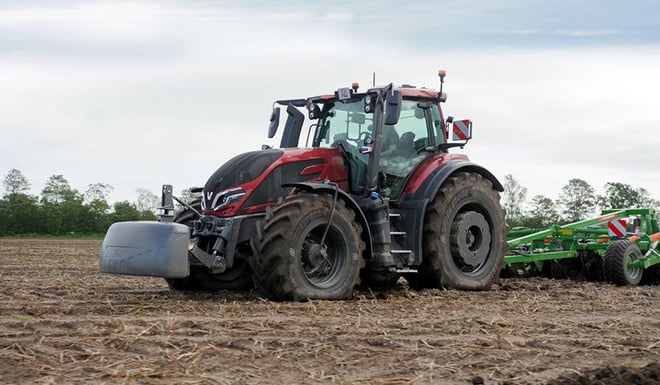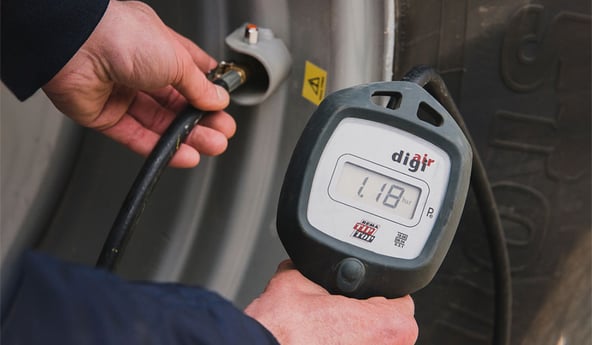Because it’s easier, many farmers choose to drive with the same pressure throughout the year, whatever the type of ground or work to be done. This easy compromise comes at a considerable cost for your farm, by reducing the wear life of your tyres by almost half, by slowing down your work rate in wet conditions and by compacting your soil, leading to a decrease in yields.
It’s true that finding the right pressure settings for your agricultural tyres may seem complex and working at low pressure can raise fears of the tyre rotating on the rim, or worse still, coming off the rim, but these problems are less pertinent if you use more high-tech tyres which have been designed to work at low pressure.
In this article we provide answers on how much impact agricultural tyre pressure settings can have on the efficiency of your work and your yields.
1. The drawbacks of incorrect agricultural tyre pressure settings
During work in the fields, incorrect pressure settings are frequent.
When the inflation pressure is too high, this has an impact on tractor handling, but also on soil compaction.
On the other hand, if the tyres are underinflated and the tyre technology does not allow work at low pressure, this can cause rapid damage to the tyre.
What are the disadvantages linked to excess pressure
The most frequent situation, to avoid changing settings which appear to be secondary, is to opt for an average inflation pressure. During work in the fields, the tyre will tend to be overinflated.
Overinflated tyres can cause excess slip, especially on wet ground, increasing fuel consumption and working time. This overinflation affects the soil structure, leading to the formation of ruts and long-term damage to the cultivable area.
Impact of incorrect pressure settings on soil compaction
High pressure has a major impact on soil compaction. This compaction affects the normal growth of the roots of your crops and reduces the absorption of nutrients. In the worst cases, this can lead to a drop in agricultural yields of up to 25%.
The economic consequences not only include a decrease in revenues, but also additional costs linked to damaged soil recovery work.
Disadvantages linked to pressure that is too low in tyres that are not suitable
The underinflation of standard structure agricultural tyres leads to problems linked to the fact that the tyre technology is not suitable for working continuously at low pressure.
The tyre will tend to crush excessively into the ground, which triggers subsidence at the centre of the tread, as well as abnormal wear to the lugs and shoulders.
The low pressure increases the risk of punctures and causes internal damage which may go unnoticed until the situation becomes critical. The lifespan of the tyres may be reduced by up to 25% as a result of premature wear. In addition, underinflation affects the stability of the vehicle, in particular when braking during cornering, and increases fuel consumption on the road, thus having a direct impact on operating costs.
2. VF tyre technology is ideal for working at a low inflation pressure
The technology of your agricultural tyres is a decisive element if you wish to improve the efficiency of your work. VF tyres, such as Bridgestone’s VT-Tractor tyres, are high-tech tyres that can work at a very low inflation pressure: 0:6 bar at low speed, or 0.8 bar at normal speed.
The technology of this tyre allows the very supple sidewalls to flatten out without altering the internal structure of the tyre. The soil footprint expands and the weight is spread over a larger contact patch with the ground. The S-line bead ensures perfect airtightness between tyre and rim, eliminating the risk of the tyre coming off the rim or rotating on the rim.
Video of the result of agronomic tests carried out with low-pressure VT-TRACTOR tyres
show the benefits of low pressure
in improving the efficiency of work in the fields.
Advantages in terms of Fuel Consumption:
- The VF tyre design optimises transmission of power to the ground, minimising the loss of energy.
- A better soil footprint reduces rolling resistance, especially on wet ground.
- Efficient use of VF tyres at low pressure leads to significant fuel savings.
Advantages for Traction:
- The better soil footprint for low-pressure VF tyres reduces slip, making the work rate better.
- The specific design of the lugs facilitates traction and avoids earth accumulating between the lugs.
Advantages for the Soil:
- VF tyres used at low pressure preserve the structure of the soil, while minimising compaction.
- They encourage the growth of the crops’ root system and biological activity in the soil.
- They allow good water infiltration to the different layers of soil, optimising yields without watering during the dry season.
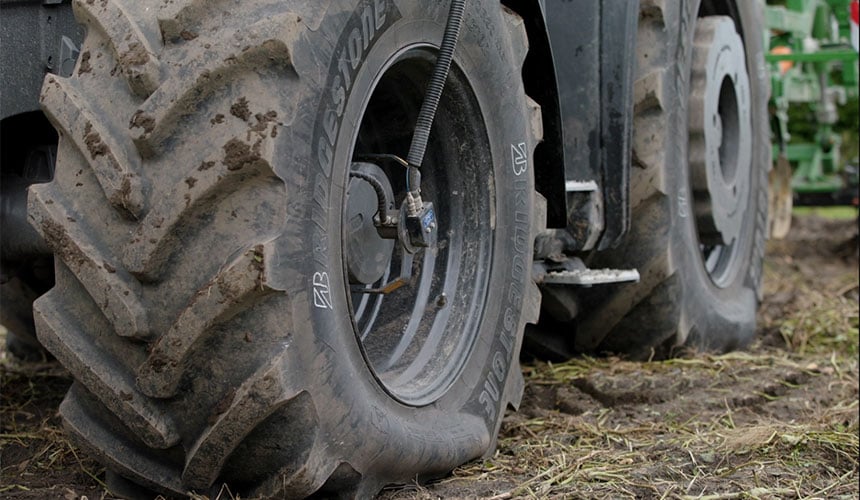
you can obtain optimal efficiency with VF VT-TRACTOR tyres
3. Working at low pressure leads to reduced fuel consumption
For work in the fields, lower tyre pressure is essential to optimise fuel consumption. By adjusting tyre pressure correctly, rolling resistance can be significantly reduced, leading to more efficient fuel consumption.
This saving is combined with reduced wear, ensuring better tyre longevity and less impact on soil structure. This represents a considerable advantage for farmers, both from an economic and ecological standpoint.
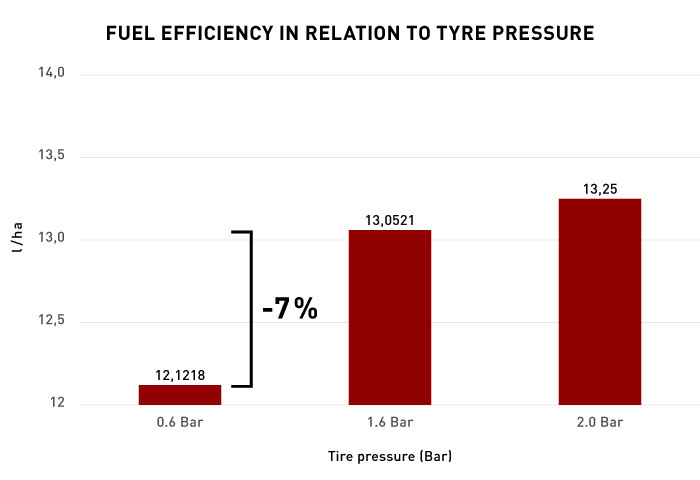
to tyre pressure: Consumption = -7% per hectare
4. Low tyre pressure leads to better traction
Here is how low pressure in agricultural tyres improves traction, a crucial aspect for the efficiency of agricultural labours. Suitable pressure, especially reduced, plays a decisive role in maximising traction.
When tyre pressure is reduced, this increases the length of the tyres’ contact patch with the ground, which leads to better adherence and considerably less slip. This improvement of the soil footprint allows the tyres to have a better grip on the ground, making the transmission of power more efficient.
Better traction means that the machines can work more efficiently in varied conditions (wet or dry soil), which allows for greater versatility in agricultural operations.
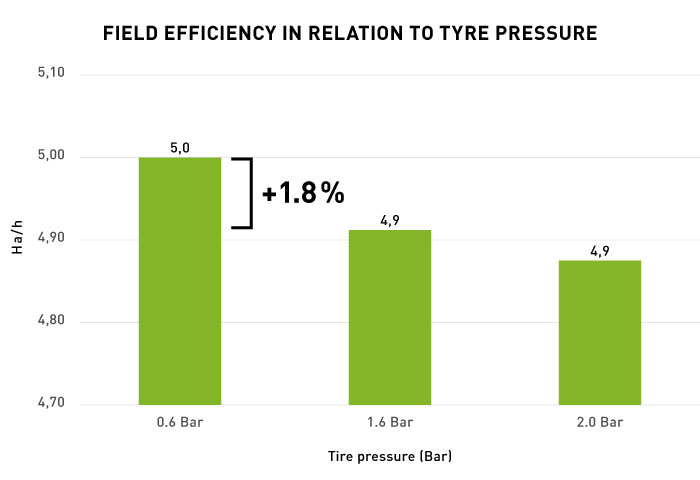
linked to tyre pressure: Traction = +1.8% per hour
Your tractor’s energy efficiency with better tyre traction
Improved traction leads to better use of tractor power, which allows you to complete tasks more rapidly with less effort. This means that farmers can cover more ground in less time, thus improving the overall productivity of their farms.
Our tests show that tyre pressure and traction are linked. By opting for low pressure, you can improve traction significantly, reduce slip, minimise tyre wear and fuel consumption while boosting the productivity of the agricultural machines.
This is a winning strategy for farmers, combining soil preservation, operational efficiency and money saving.
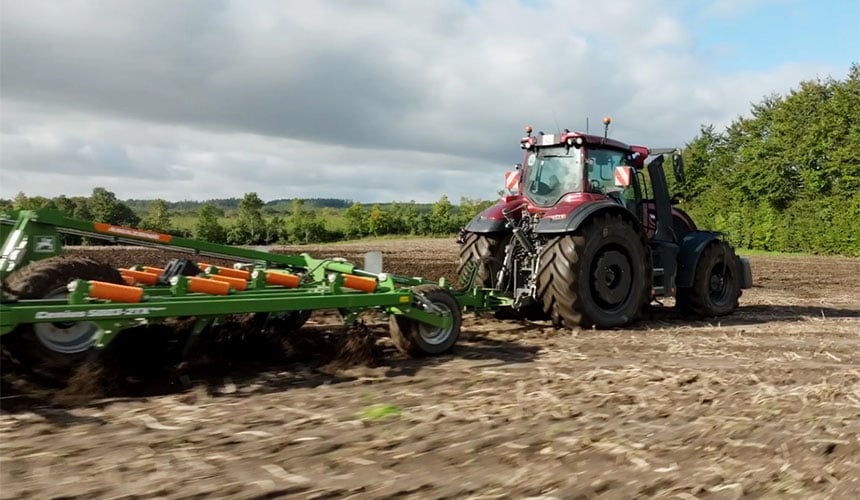
5. Low tyre pressure is necessary for soil preservation
Low pressure in tyres is certainly the most important factor in terms of soil preservation and the reduction of compaction. When tyres are overinflated, often to compensate for load, they exert considerable pressure to the ground, leading to compaction.
This compaction reduces soil porosity, limiting the circulation of water and air and preventing growth in crop roots.
Soil preservation: less pressure equals less compaction
The use of low-pressure tyres increases the contact patch with the ground, spreading the load more evenly and decreasing the pressure on each square centimetre of ground.
This improved weight distribution helps to preserve the structure of the soil, its capacity to retain water and its fertility, encouraging more healthy crop development.

the length and width of the tyre footprint
Non compacted soils are more resistant to erosion and extreme weather conditions, ensuring sustainable agricultural productivity.
Optimal management of tyre pressure is therefore a key factor in maintaining soil health, which is essential for more profitable farming.
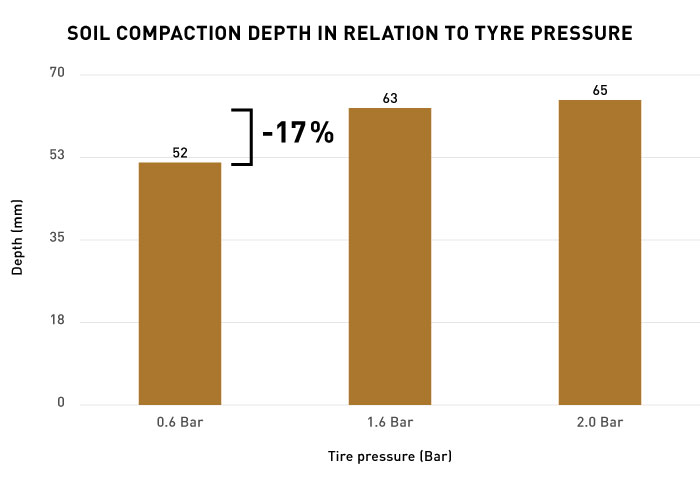
CONCLUSION
Appropriate management of agricultural tyre pressure, in particular by using tyre technology such as Bridgestone’s VT-Tractor tyre, makes it possible to work at a very low inflation pressure. This offers significant advantages: better traction, a reduction in fuel consumption, less soil compaction and a better preservation of the soil structure.
By choosing the VT-Tractor tyre, you can optimise the efficiency of your work while contributing to the sustainability of your environment. This balance between performance and environmental protection represents a step forward in current agricultural practices.
The Bridgestone-agriculture.eu blog is written and administered by tractor tyre experts who are available to provide you with the advice that you need about your farming tyres. They will help you to maximise your productivity with information on all things relating to tyres: inexpensive tractor tyres - technical data for farming tyres - advice on farming tyre pressure - solution to avoid soil compaction - sprayer tyre pressure - Why and how to ballast your tractor tyres - when to use twin wheels - the mechanical causes of abnormal wear - cheap agricultural tyres - etc.
To take it a step further and increase the profitability of your farm, the tractor tyre experts has prepared a free, highly detailed, ebook which explains the essential role of farming tyres on your productivity.
Most people who read this article have also read some of the following articles:
- 12 simple tips to better manage the pressure of your agricultural tyres
- Farming tyres, pressure monitoring or full Central Tyre Inflation System CTIS
- 7 advantages of low-pressure tyres compared to normal tyres
- What is the right inflation pressure for any tractor tyre
- The keys to working at very low pressure with your agricultural tyres
- Understanding your tractor tyres’ pressure -load -speed link
- Tank Air Wheel rims, to inflate tyres in 1 minute
- Can you go beyond the recommended pressure for your tractor tyres?
- Opt for a harvest campaign with low-pressure tyres
- 11 keys for knowing everything about agricultural tyre pressure
This information is intended only to make you aware of the technical and functional aspects of agricultural tires and their use. It does not allow you to make a judgment or a definitive conclusion on a given problem. Only your agricultural tire expert is able to make a technical assessment and take a final decision, case by case.
Leave a
commentary
Your email address will not be published.
Required fields are indicated with *


